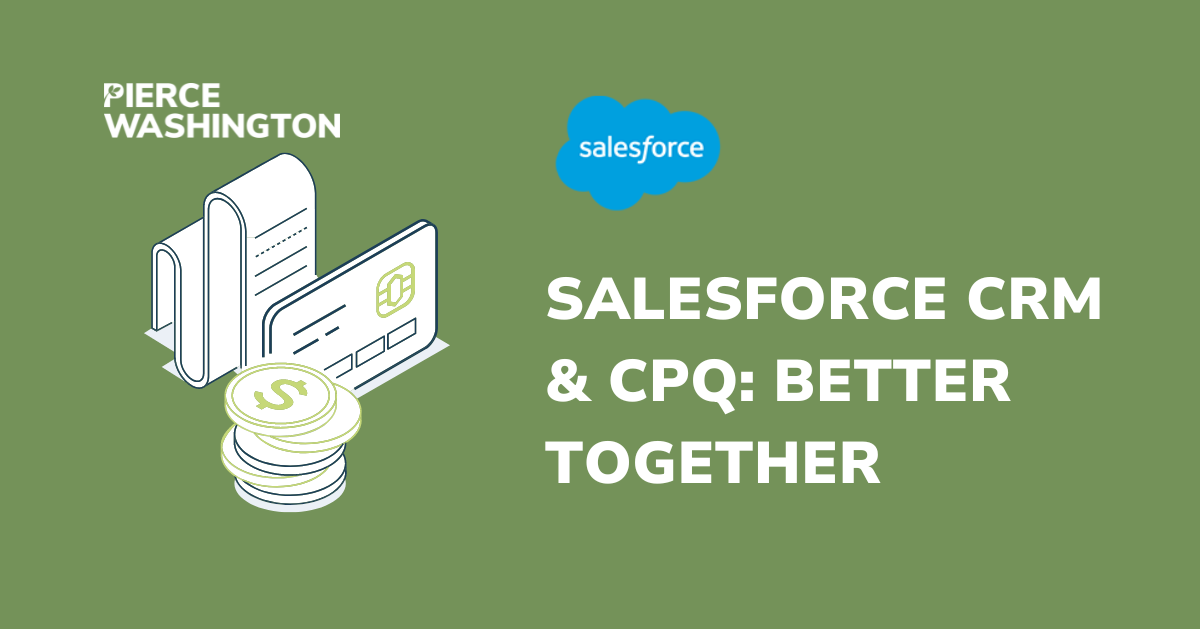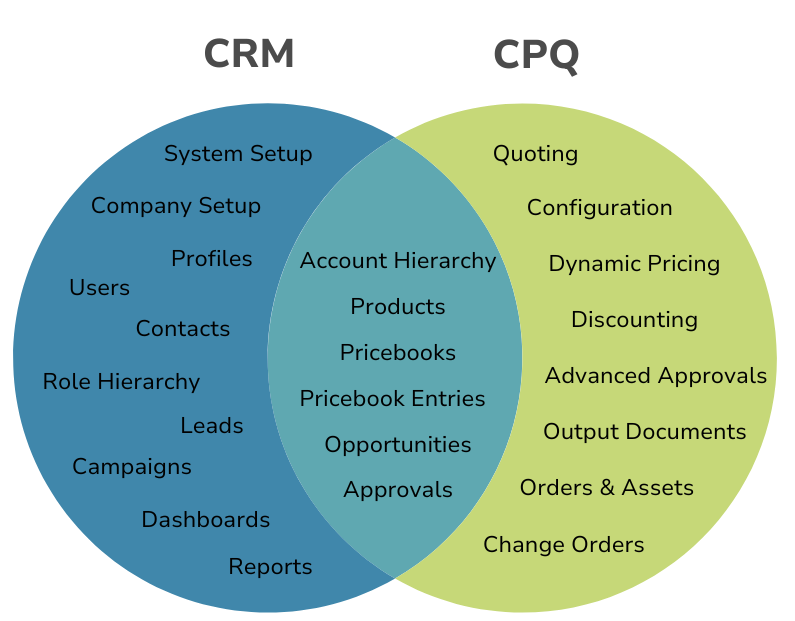Intersted in Salesforce CRM & CPQ?
The following insights can save you up to 50% in consulting time and tens or hundreds of thousands of dollars in implementation fees.
If you’re in the consideration phase with Salesforce CRM or CPQ implementation partners, this article is perfect for you. It answers common questions like, what parts of the sales cycle do CRM and CPQ cover and where do they overlap? Do you need both? If so, what’s the best sequence and strategy? And is one SI (system integrator) or two better for your Salesforce CRM and CPQ implementations?
The valuable Salesforce CRM insights and CPQ best practices in this quick article can accelerate your company’s revenue transformation, dramatically reduce your overall costs, and help ensure the best possible results. Read on to see how.
First, a little clarity around Salesforce CRM and CPQ.
Salesforce Sales Cloud is CRM (customer relationship management).
CRM is a basic customer database and the foundation of Salesforce. It’s both technology and a strategy for managing and analyzing customer interactions and data. CRM begins at the point of new lead and extends through the sales pipeline and ends with closing out deals. The purpose of CRM is to enable sales growth by improving customer relationships and retention.
Salesforce Revenue Cloud is CPQ (configure, price, quote).
CPQ software automates the process of configuring products or services. It determines accurate pricing and generates detailed quotes for customers. CPQ starts at the point of quote creation and extends throughout the remainder of the sales cycle to the order point. CPQ streamlines sales processes, reduces errors, and enhances the efficiency and accuracy of complex sales transactions.
This chart shows a typical business process flow and what parts of the sales cycle relate to CRM and CPQ.
IMAGE***
CRM begins the moment a lead comes into the opportunity pipeline and continues through lead qualification, opportunity conversion, and account creation. CRM ends there. CPQ goes into effect when a quote is created and it continues through product selection, discounting, approval, documentation, signature, and order creation. To put it another way, CRM provides detailed information about customer interactions, preferences, and purchase history. Then CPQ leverages that information to precisely configure products or services, set accurate pricing, and generate tailored quotes.
CRM and CPQ overlap, sharing key customer data and product information.
The two software systems interact extensively. The following Venn diagram shows what information and functions CRM and CPQ include exclusively and what information they share. Think of the three colored areas in the diagram as requirement buckets to set up the complete system.
CRM and CPQ work together to cover the full spectrum of customer transactions. For example, imagine your company needs to ship a product to a customer in Dallas, but bill their home office in Minneapolis. This transaction requires the Account Hierarchy shared by your CRM and CPQ to be set up correctly with defined rules and allow the data to flow freely between each system.
Unless you sell a single unconfigurable widget, you need both CRM and CPQ.
CRM is accepted as business-critical today and CPQ is now viewed similarly. In fact, both are vital for a wide range of companies, from large ones with complex, configurable products down to small companies that do basic quoting on products or services with any degree of configurability.
Think of it this way. If your product or service has more than one option, your business will benefit tremendously from having CRM integrated with CPQ. The two systems allow sales teams to quickly create personalized and precise quotes based on real-time customer data. The result is less errors and shorter sales cycles due to accelerated quote generation.
The synergy between fully integrated CRM and CPQ creates a more streamlined sales process. It improves customer satisfaction by providing more accurate pricing and configurations. And it boosts revenue through better self-service and more upselling and cross-selling opportunities. The combined solution is more powerful and impactful to your bottom-line than CRM alone, or than the two systems operating independently.
Implement CRM first then CPQ. Or better yet, do them simultaneously.
CRM is the foundation that you build CPQ on top of. CRM is generally considered more straightforward, and it requires a little less time and cost to implement than CPQ.
CPQ is the next step up in revenue lifecycle management. You would never implement just CPQ before or without CRM. CPQ naturally follows CRM, touching all remaining aspects of transactions through revenue recognition. CPQ is a bit of a heavier lift in terms of implementation hours due to its greater complexity.
You can adopt CRM and CPQ independently if necessary due to budget or other constraints. But there are clear and measurable advantages to implementing the two systems together. That’s because they share so much of the same upfront analysis, customer data, and product information. Implementing CRM and CPQ at the same time also creates a more seamless integration of customer data with the sales process.
Save time and money by working with just one SI for both CRM and CPQ.
The perspective on one versus multiple CRM and CPQ implementation partners has shifted over time. It’s a good question with an easy answer—one SI (system integrator) is best.
There are several concrete benefits to working with a single SI, assuming that SI is highly capable with extensive and specialized expertise in both CPQ and Salesforce CRM. A lengthy history and proven track record in this space is also a must when choosing your SI.
Because CRM comes first and generally requires a little less expertise, it’s tempting to start with a lower-cost SI to get your CRM stood up with basic functionality. Initially, this can be less expensive. But it will cost your company more later when you adopt CPQ with a more advanced SI that can do the full process end to end.
CRM and CPQ best practices suggest that if you know you’re going to implement CPQ in the future (even if you’re doing CRM in a first phase), start with the more advanced CPQ SI. Then work backward to implement your CRM and eventually integrate the two.
With one fully capable SI, you’ll explain your business just once, and you’ll build out your project just once. This shrinks timelines and project costs.
- Tech Benefits: Your products or services are a key piece of all this. If you’re building them out in CRM with separate teams, you’ll have to rebuild them again in CPQ. Each SI will want to do it their own way. The result is a lot of double work, which is throwaway work. You’ll pay two teams to do similar work. Plus, you’ll incur the redundant cost of your own team’s precious time, effort, and energy. One team is more efficient because it applies the work to both systems.
- Cost Benefits: One CRM and CPQ implementation partner reduces consulting time and fees. PW’s chief Salesforce software architect estimates 50% of rework is caused by having two teams doing initial discovery, plus another 30-35% of rework is required to do the actual CRM and CPQ implementations. This is based on a hypothetical enterprise-level project requiring 1,500 hours for CRM and 2,000 hours for CPQ implementation. Based on typical industry hourly rates, this can easily translate to $150,000 in cost savings when working with a single SI.
- People Benefits: Just getting all the right people in a room, and having the right conversations, is no small task. Finding your best-fit SI and developing a productive working relationship—and vital trust—takes time. In fact, information transfer is one of biggest parts of these projects. An SI has to really dig in, ramp up, do the analysis, and understand your process, products, warranties, and all the different pieces of your revenue lifecycle. None of this is instant or easy. Doing it twice is harder.
4 Key Takeaways:
- CRM and CPQ are business necessities today. They upgrade the entire revenue lifecycle. The two systems are synergistic—more transformative together. Every business with a configurable product or service needs both systems to compete and succeed in the 2020’s.
- Don’t treat CRM and CPQ as isolated projects. Make them part of one plan and build with both in mind. Ideally, do the two projects concurrently for maximum efficiency and seamless integration of the two systems.
- If you know you’re going to implement CPQ eventually, but you have to do them in phases, start with Salesforce CRM. But work with a CPQ specialist that knows both systems really well.
- Work with one SI over multiple Salesforce CRM and CPQ implementation partners. If you do CRM and CPQ with different SI’s, you’re doing the twice the work and incurring considerably more fees and expense.
Pierce Washington has deep experience in CRM and CPQ implementations.
We are CRM and CPQ implementation partners with both Salesforce and Oracle. We know their CRM and CPQ best practices inside out, including the new RLM (revenue lifecycle management) software from Salesforce, which encompasses both CRM and CPQ. Today, we have 20 years of experience doing these specialized, end-to-end implementations. We bring all the priceless lessons we’ve learned over two decades to every revenue–transformation project we do.
PW was founded by hardcore tech nerds and software architects. We thrive on highly complex projects and doing the most challenging use cases with the most sophisticated tech. Today, we have 20 years of experience doing these specialized, end-to-end implementations. We bring all the priceless lessons we’ve learned over two decades to every revenue–transformation project we do.

